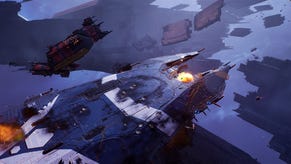How Iconoclasts makes platforming flow
Kinetic engineering
This is The Mechanic, where Alex Wiltshire invites developers to discuss the difficult journeys they underwent to make the best bits of their games. This time, Iconoclasts [official site].
Iconoclasts is a platformer that feels great to play. As Robin, a daring mechanic armed with a wrench and a stun gun, you’ll run, jump and shoot your way through sprawling multi-level areas, enjoying precise movements which balance detail and nuance with smoothness. It’s a feel that’s down to developer Joakim Sandberg’s taste in games. ”Something I always enjoy in a videogame is that feeling, usually when you’ve played it a few times, of being able to push through,” he tells me. “Flow, essentially.”
Almost all of Iconoclasts’ design features are directly about maintaining this sense of flow, of momentum in which you feel like nothing is getting in the way of your intention. And one feature you’ll notice when you first start playing the game is kind of shocking.
While exploring a cavern at the start of the game you’ll encounter floor-crawling bugs, and as you begin firing Robin’s stun gun you’ll see her aim snap to them from obtuse angles. In fact, it’ll aim at a target within 45 degrees of either side of where you’re looking. At first, it’s rather confounding. Is this going to make Iconoclasts overly easy? Where’s the challenge if you don’t have to aim very accurately to hit stuff? Why are there enemies if they’re so easy to kill?
But once you think about it in the context of flow, this aiming design starts to make sense. ”There are a lot of 2D scrolling games where you have an enemy just above your line of fire,” Sandberg says. But instead of making you do little jumps to shoot horizontally at them, as in Mega Man, or to include extra aiming buttons to point right at them, as in Metroid, he decided on a strong aim-assist. The result, once you’re familiar with the game and its controls, is that shooting Iconoclasts’ simpler enemies flows into your movement.
“It doesn’t necessarily have to make the game easier, it’s all about how you design around your mechanics to improve the feeling of the game. Killing an enemy easily doesn’t have to make the game easier if you design around that part.”
Iconoclasts is filled with little design features which reflect this philosophy. After a certain point in the game you can electrify Robin in order to automatically activate switches as she passes. Doors open fast enough that you don’t have to stop. You don’t have to learn new buttons as Robin gets new abilities because they sit on the ones you already use. “You don’t need to learn new ways of input, so you’re already ready to go and you’re doing what you already know, but the results become different. It isn’t just Sonic the Hedgehog, where it’s all about not stopping, it’s purely the fact that you’re never interrupted by something that you already have a feel for.”
And then there’s the platforming. Metroid is frequently cited as a core inspiration for Iconoclasts (a much closer one is, in fact, Monster World IV), and it’s definitely there. Robin can hang from ledges like Samus and fits into small spaces (although she doesn’t turn into a ball). Sure, her jump is completely different - have you played a 2D Metroid game recently and remembered how weird and complex the Metroid jump is? - but Iconoclasts shares its deterministic nature. Because the levels are built from tiles you gain a strong awareness of how far Robin can leap and when a gap is a gap too far.
”That’s possible when you have very locked visuals, like old games tended to,” says Sandberg. “When I saw the Mighty No. 9 reveal, I was surprised they were going to go with a 2.5D presentation because Mega Man to me had always been so much about a straight, side-on view because it’s so clear, and Mega Man really measures everything you do, or you die.”
Iconoclasts is less exacting. Like many platformers, it gives you a few milliseconds to jump after Robin has progressed past the edge of a platform. “That’s a really important thing to me. In the same way, if you want to jump twice in a row, when you press just before landing it still counts so that you jump again.” Similarly, pressing the wrench button as it’s completing a swing will immediately take another. “If you don’t do that, you have to figure out the exact timing to attack as fast as possible. Some games do that, but they shouldn’t.” Why, Sandberg asks, get in the way of the game feeling good?
Rather than making controlling Robin overly simple, Sandberg was anxious to add in extra rewarding features, such as the ability to grab and swing from objects with a well-timed press of the wrench button. The timing needs to be quite precise, but it gives Robin a surprisingly high boost into the air. “You feel like you’re doing a trick and you want the reward every time,” he says.
He also designed skill moves into the game, which aren’t explicitly taught to the player and can allow them to skip chunks of the game. There’s a double-jump, performed by charging the stun gun and then discharging it while aiming downward in mid-air. It can also boost when running horizontally, and there are ways of climbing ladders quicker.
”They’re technically secret, but if they’re easy to figure out without instructing anyone they become a normal move which the player feels like they discovered,” says Sandberg. “That adds a lot to appreciating a game. Most of the time, people find these things and it’s about them feeling they’re making the game faster and more flowing and more exploitatable, even though it’s for the benefit of the game. This little hidden moves make you feel clever.
“There’s also a dodge roll, which seems to be able to break the game,” Sandberg continues. “Some speedrunners really like that move and I have to consider what I can do to allow them to do it while stopping casual players from breaking the game.”
Sandberg gave Iconoclasts to several speedrunners to play while making it because they’re very good at finding exploits. “They were really useful,” he says. “I think people should hire speedrunners specifically.” They helped him decide which tricks he’d keep in the game and which were a problem: it was important that first-time players didn’t discover them, so that exploits are only the province of the experienced and the determined. One issue was a boss which grabs Robin during their encounter. But he realised that Robin’s hitbox was still active, and if a projectile hit her, it would send the boss flying into the air, potentially allowing the player to skip the sequence. “The random nature of how that happens, I can’t let that stay in the game.”
Iconoclasts’ bosses largely come from the tradition of posing players with exams, tests of what they’ve learned in the preceding area. After you get the grenade launcher, you get a boss that you need to fire grenades at to defeat. Here, Sandberg looked back to bosses from games like Contra, which seem incredibly difficult until you learn the trick, after which they go down in seconds. Again, it’s down to his take on flow: never being interrupted by something that you already have a feel for.
Some bosses, however, add new things to learn, such as one in which you suddenly encounter a new mechanic: switching between two playable characters. “To me anyway, that was a fun twist on having to teach something in a stressful situation. Maybe some people don’t like it, but I really like the idea of having to figure out something in a boss fight. Basically, I try to make every boss its own thing, somehow.”
In Iconoclasts’ interpretation of flow, bosses can stop players and make them figure out how they can be defeated. It can also present players with puzzles that hold them until they’re solved. While it’s very much a kinetic game, founded on the satisfaction of crossing spaces with skill, that’s only one facet of how it keeps you in the moment. Iconoclasts is happy to make you stop, as long as it’s in order to engage in a new challenge.
Iconoclasts is available now for Windows, Mac and Linux, via Steam and gog.










